The major pentatonic scale is an essential element in music theory, known for its five-note composition that differentiates it from the traditional seven-note major scale.
This scale is super versatile and can help create melodies, harmonies, and solos that really stick with the listener.
Understanding the intricacies of that major pentatonic sound is key for any music producer looking to enhance their music skills and achieve a professional sound.
It’s essential for understanding how to convey certain emotions simply through a sequence of notes.
In today’s article, we’ll be breaking down:
- The structure of the major pentatonic scale ✓
- Differences between major pentatonic scales & minor pentatonic scales ✓
- More detail on scale formulas, scale patterns, and major pentatonic notes ✓
- Deep dives into specific scales like the C major pentatonic scale ✓
- How this knowledge can help you create enchanting melodies ✓
- Chord progression insights (+ pro tips) ✓
- Major chord vs minor chord techniques ✓
- Improvisation and soloing with the major scale (and minor scales) ✓
- Scale shapes and patterns on instruments ✓
- Creative uses of the major pentatonic scale in music production ✓
- Programming MIDI with pentatonic scales ✓
- Much more about the major and minor pentatonic scales ✓
By the end, you will have learned some serious knowledge about the major pentatonic scale so you can apply it effectively in your tracks.
You’ll be equipped to create more captivating melodies and enhance your chord progressions with confidence.
So, let’s dive into this popular scale…
Table of Contents
- What is the Major Pentatonic Scale?
- Comparing Major Pentatonic Scales and Minor Pentatonic Scales
- Expert Uses of the Major Pentatonic Scale
- The Unison Major Pentatonic (Bluegrass) Advanced Scales MIDI Collection
- Understanding Scale Shapes and Patterns
- Using the Major Pentatonic Scale Creatively
- Major Pentatonic Scale: Final Thoughts
What is the Major Pentatonic Scale?
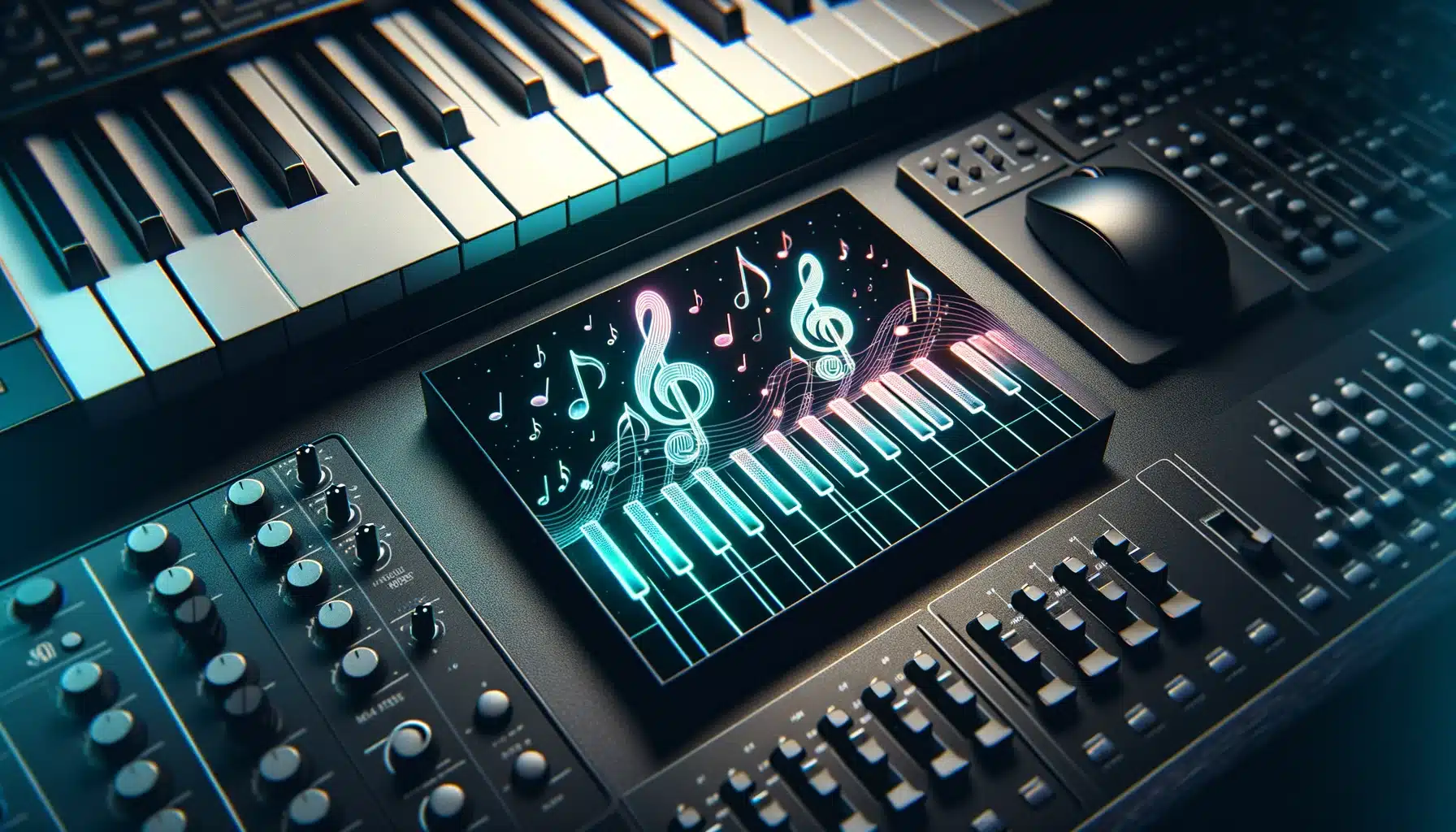
The major pentatonic scale is a fundamental element in music production.
It offers a simplified yet versatile opportunity for creating melodies and harmonies with its unique scale shape.
The major pentatonic scale is, of course, derived from the major scale 一 consisting of five notes per octave instead of seven.
This intriguing scale removes the fourth and seventh degrees from the major scale (like the C major scale).
It results in a (five-note scale) sequence that’s easier to use and more harmonically open.
For digital music producers like yourself, understanding the major pentatonic scale is crucial for creating engaging and melodically solid tracks across various genres.
When diving into the major pentatonic scale, it’s essential to grasp its formation.
Take the C major scale, for instance, which includes the notes C, D, E, F, G, A, and B…
By applying the major pentatonic formula and its unique scale formula, we remove the F and B, leaving us with the C major pentatonic scale: C, D, E, G, A.
This scale is not only simpler but also incredibly flexible 一 providing a solid foundation for melodies that sound good in almost any musical context.
The beauty of the major pentatonic scale, and its five notes, lies in its adaptability and ease of integration into music production workflows.
Whether you’re laying down a soulful lead in an R&B track, creating an uplifting chorus in a pop song, or adding atmospheric melodies to an EDM banger, the major pentatonic scale can elevate your music.
And, more importantly, help your tracks resonate on a deep emotional level.
-
The Unique Charm of Major Pentatonic Scale
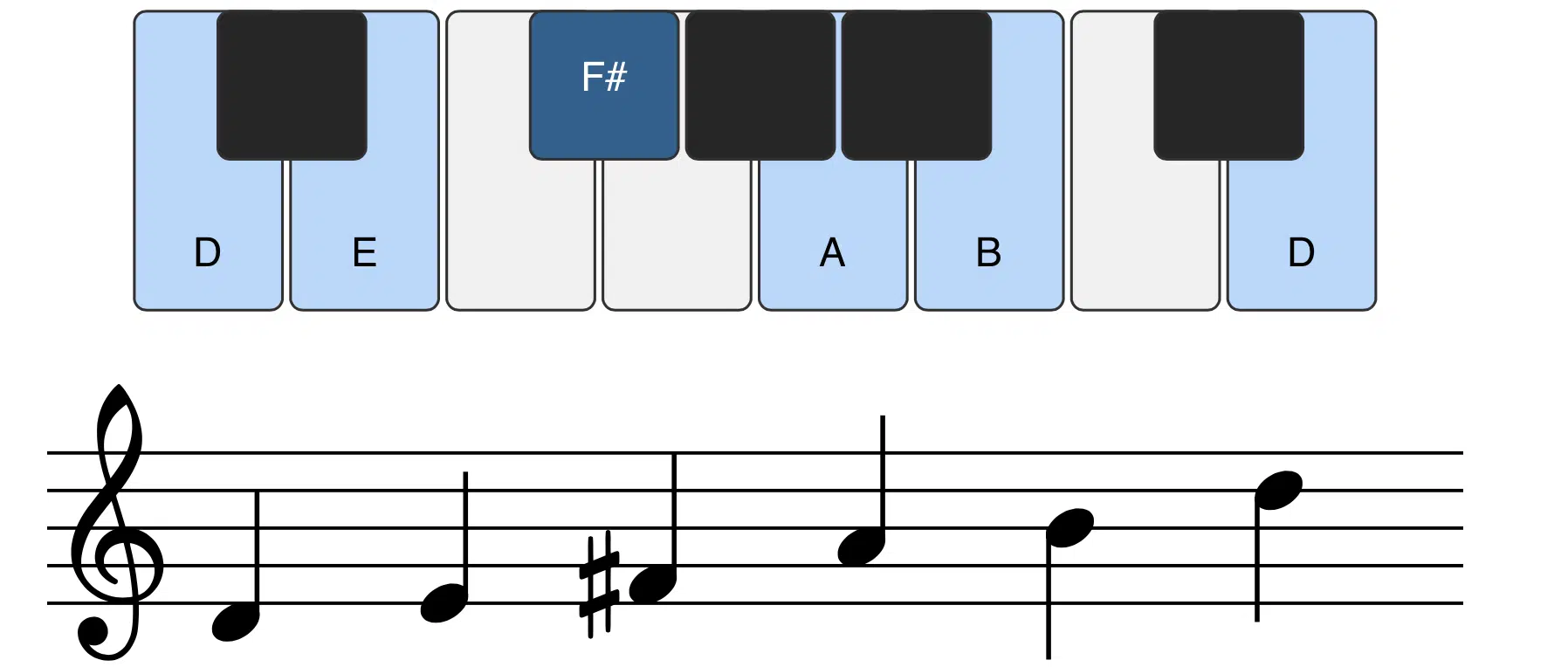
The D Major Pentatonic Scale
What sets the major pentatonic scale apart is its natural musicality and the emotional depth it offers.
It excels in creating clear, resonant melodies that can convey a wide range of emotions 一 from joyful to maniacal and everything in between (if used right).
Its structure avoids the potentially dissonant intervals found in other scales, which makes it a go-to choice for producing universally appealing music.
A prime example of the major pentatonic scale’s charm can be found in the iconic riff of “My Girl” by The Temptations.
It utilizes the C major pentatonic scale to create a melody that’s instantly recognizable and emotionally stirring.
This gives you an idea of how the major pentatonic scale can be used to create unforgettable hooks that stand the test of time.
-
Pro Tip: The C Major Pentatonic Scale
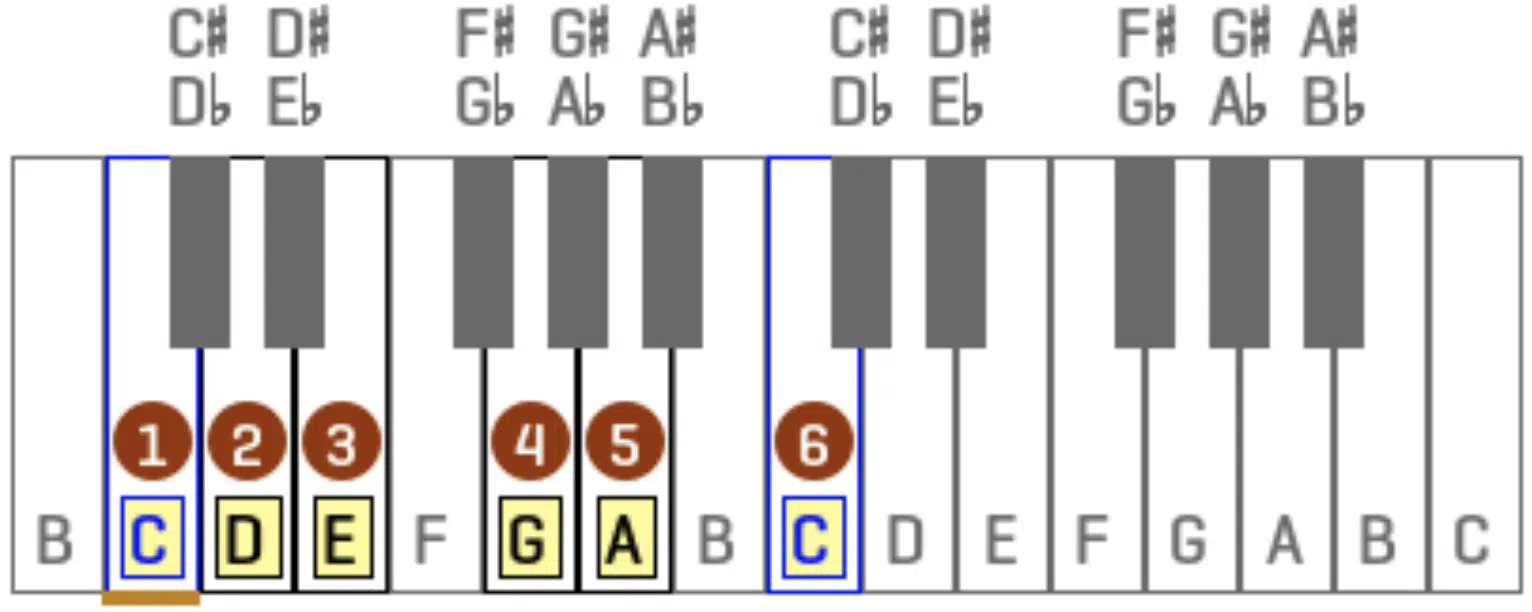
The C major pentatonic scale (with its notes C, D, E, G, A) exemplifies the scale’s adaptability across genres.
It’s particularly effective in creating bright, uplifting melodies that can serve as the backbone of a track or as accentuating moments.
Using the C major pentatonic scale, you can effortlessly create lines that fit seamlessly over various chord progressions 一 getting a cohesive, solid sound every time.
The absence of any half-step in the C major scale minimizes dissonance.
It allows for smoother transitions between notes, which makes the C major scale a popular choice for solos and lead lines in everything from pop and rock to blues and country.
Comparing Major Pentatonic Scales and Minor Pentatonic Scales
The differences between major pentatonic scales and minor pentatonic scales prove the versatility of pentatonic scales in music production. So, let’s check out the key differences so you can integrate them like a true pro.
-
The Major Pentatonic Scale

Ab Major Scale (left), Ab Major Pentatonic Scale (right)
The major pentatonic scale, derived from the major scale by excluding its:
- Fourth degree
- Seventh degree
It gives you that super cheery, bright tonality.
For instance, the C major pentatonic scale (C, D, E, G, A) is extracted from the C major scale (C, D, E, F, G, A, B) by removing the F and B notes.
Therefore, it gives you a major scale that’s versatile and harmonically pleasing.
Again, the C major scale is always ideal for creating uplifting and melodious tracks, so keep that in mind.
-
The Minor Pentatonic Scale

F Minor Scale (left), F Minor Pentatonic Scale (right)
The minor pentatonic scale, such as the A minor pentatonic scale (A, C, D, E, G), is formed by taking, from the A minor scale, the:
- First note
- Third note
- Fourth note
- Fifth note
- Seventh note
Therefore, this minor scale offers a darker, more introspective sound.
The use of these scales (minor scale/major scale pentatonics) can significantly affect the mood and emotion conveyed in your track.
-
In a Nutshell

In a nutshell, the major and minor pentatonic scales convey the same emotions as the traditional relative major/minor scale.
The major pentatonic scales, with their absence of semitones (a half step), avoid creating tension and dissonance.
This makes major pentatonic scales perfect for smooth, engaging melodies and harmonies.
They are especially prevalent in genres that favor clear, singable melodies, such as pop, country, and folk music.
Minor pentatonic scales are favored in genres like blues, rock, and jazz, where their somber and soulful qualities can be used to express depth, sadness, or introspection.
The contrast between the bright, optimistic tones of major pentatonic scales and the moody sounds of minor pentatonic scales provides endless musical opportunities.
For example, transitioning from the uplifting G major pentatonic scale (G, A, B, D, E) to the reflective E minor pentatonic scale (E, G, A, B, D) within the same piece can add complexity and contrast.
In turn, your audience will get an enhanced listening experience.
This versatility highlights why both the major pentatonic scale and minor pentatonic scales are indispensable tools in the songwriting process.
Expert Uses of the Major Pentatonic Scale
The major pentatonic scale is not just a theoretical concept but a practical tool that has been used to create some of the most memorable melodies and solos in music history. Its simplicity and musicality make it an indispensable resource for digital music producers looking to elevate their tracks.
-
Creating Melodies with the Major Pentatonic Scale
Creating melodies with the major pentatonic scale is a fundamental technique in certain popular genres (like pop music, for example).
It’s celebrated for its ability to generate catchy, memorable tunes with a wide appeal and that annoyingly beautiful power to stick in your head for days.
This scale’s simplicity, derived from removing the potentially dissonant fourth and seventh degrees from the major scale, makes it an excellent choice for melody construction.
As we discussed, for example, the C major pentatonic scale (notes C, D, E, G, and A) offers a straightforward yet effective framework for creating engaging melodic lines.
NOTE: A super popular pop song that uses the power of the major pentatonic scale in creating infectious melodies is “Shape of You” by Ed Sheeran.
This track leans heavily on the E minor pentatonic scale for its verse and chorus 一 creating a groove that’s both catchy and rhythmically engaging.
Despite being in a minor key, the song’s melody has a major quality due to the pentatonic scale’s inherent versatility and Sheeran’s upbeat delivery.
The scale’s notes (E, G, A, B, D) are utilized throughout the melody.
It showcases how the major pentatonic scale can be adapted to fit even minor keys by focusing on the relative major, in this case, G major, which shares the same notes.
Pro Tip
When creating with the major pentatonic scale, it’s beneficial to experiment with its note scale over various chord progressions within the same key. This will help you discover unique melodic opportunities. It allows for the creation of harmonious and uplifting melodies that can stand out in the competitive landscape of modern pop music.
-
Using the Major Pentatonic in Chord Progressions

The major pentatonic scale also shines when used in conjunction with chord progressions.
By aligning the scale’s notes with the chords of the same key, you can create a harmonious backdrop for your beats.
For example, in a chord progression moving from C major to G major, melodies (or embellishments) derived from the C major pentatonic scale will maintain coherence and musicality.
This production technique is particularly effective in genres like country and rock, where the major pentatonic scale adds a layer of richness and emotional depth to chord progressions.
By emphasizing certain notes of the scale over corresponding chords, you can highlight moments of tension and release.
It will add that extra dynamic interest to your songs.
-
Improvisation and Soloing Techniques
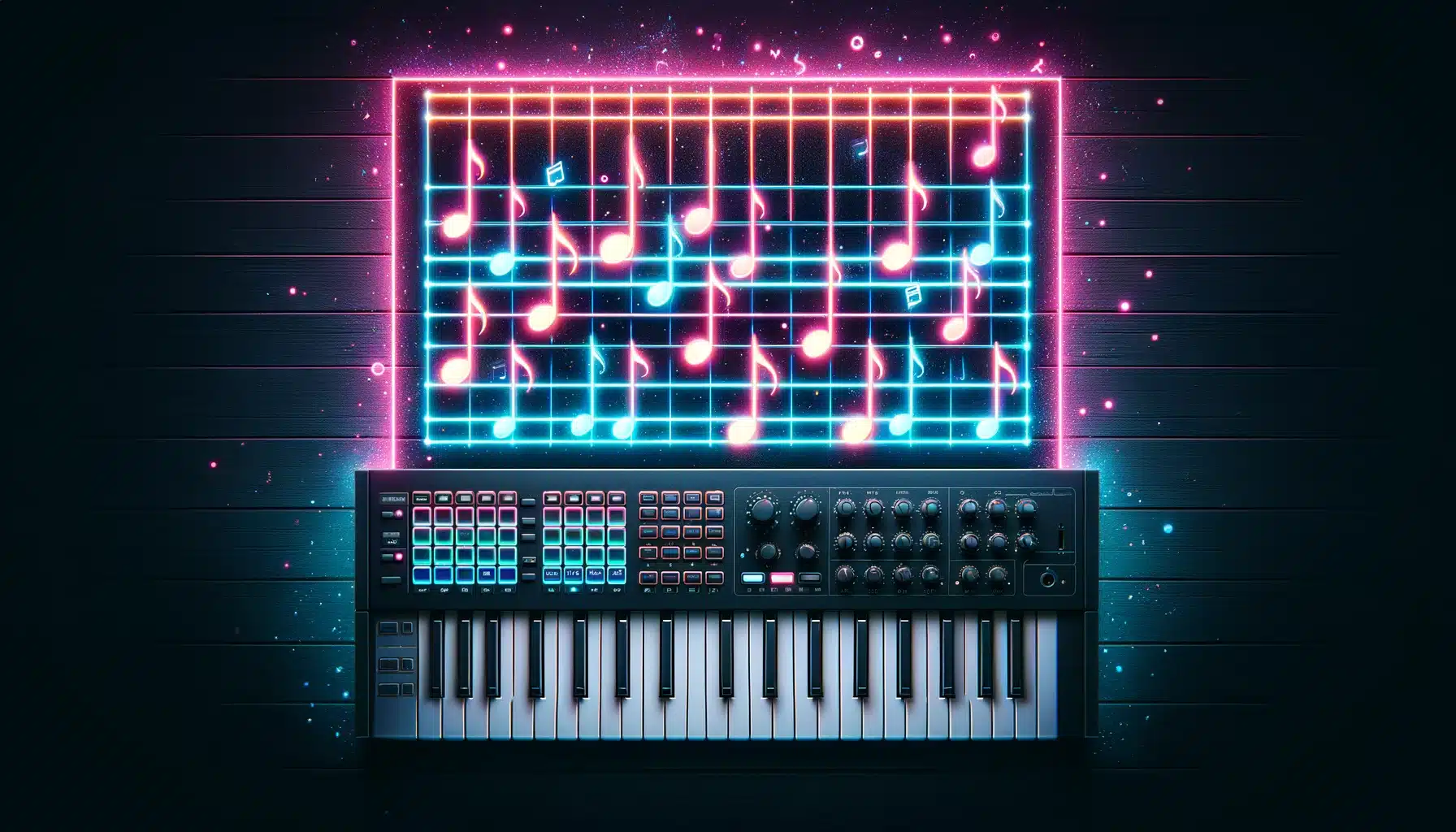
The major pentatonic scale is a favorite among most guitarists (think, major pentatonic licks) and keyboardists for improvisation and soloing.
This is because it has a very forgiving structure and melodic potential.
It allows for expressive, fluid solos that can fit over a variety of chord progressions, harmonies, and musical styles.
Taking the G major pentatonic scale (G, A, B, D, E), you can navigate the fretboard or keyboard with ease.
Don’t forget to experiment with different:
This will help you create solos that are both innovative and harmonically sound.
In blues and rock, where improvisation is a key element, the major pentatonic scale provides a solid foundation on which artists and producers can build their solos.
Legendary guitar solos, often improvised, utilize the major pentatonic scale to achieve a sound that is familiar and thrillingly spontaneous.
The Unison Major Pentatonic (Bluegrass) Advanced Scales MIDI Collection
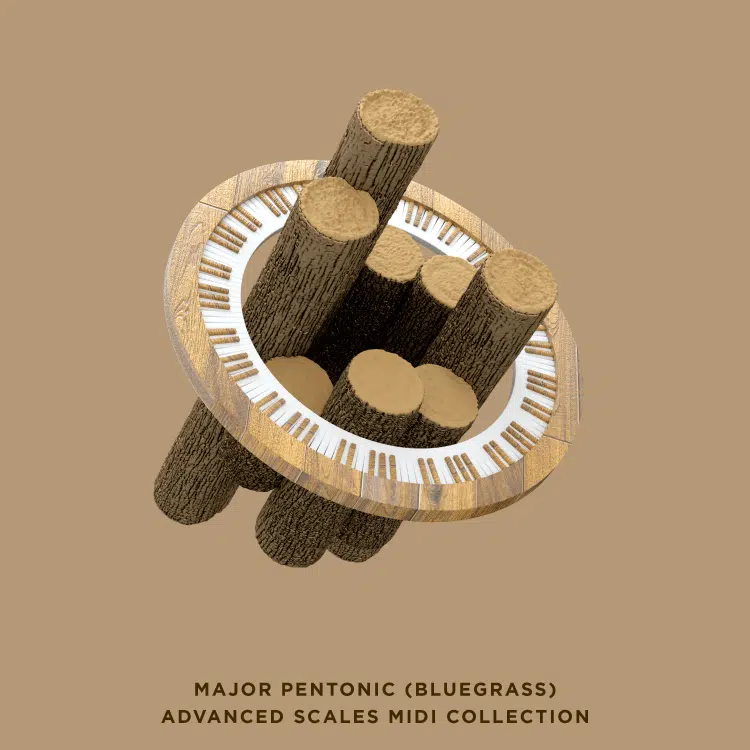
Speaking of mastering the major pentatonic scale, the Unison Major Pentatonic (Bluegrass) Advanced Scales MIDI Collection is one of the most valuable resources available.
This extensive collection provides over 1,100 MIDI files, including:
- Scales
- Chords
- Progressions
- Melodies
They’re all specifically designed to enhance your music production flow and help you add extra depth to your tracks.
The focus on the pentatonic’s five-note scale (as opposed to traditional seven-note scales) offers a streamlined approach to songwriting 一 opening new avenues for creative expression.
To develop this legendary MIDI pack, Unison has delved into the patterns that have accelerated major pentatonic tracks to the top of the charts on Billboard, Spotify, and other platforms.
Then, they used all their knowledge to create a curated selection of MIDI files that beautifully emulate these patterns.
This process ensures that you’ll have access to high-quality sounds that reflect current musical trends.
Plus, the flexibility of the MIDI format allows for easy integration and customization, so you can edit and adapt these elements to suit their unique creative vision.
So, if you’re looking to master the major pentatonic scale, simplify your creation process, and make tracks that stand out in a competitive field, this pack is your ticket.
Unison Major Pentatonic Advanced Scales MIDI Collection
Understanding Scale Shapes and Patterns
The ability to visualize and apply scale shapes and patterns across the fretboard is crucial for maximizing the creative potential of the major pentatonic scale. It encourages fluid movement and improvisation, enabling musicians (like yourself) to explore new textures and sonic landscapes.
-
Mastering Scale Shapes Across the Fretboard

G Major Pentatonic
Scale shapes, or the physical patterns notes form on the instrument’s fretboard, are essential for unlocking the full potential of the major pentatonic scale.
By learning these shapes, you can seamlessly transition between octaves and keys, expanding your expressive capabilities.
The G major pentatonic scale shown above, for example, can be played in multiple positions (1-5) across the guitar fretboard.
Each one offers a unique timbral quality and enables different melodic ideas.
Understanding these patterns also allows for greater improvisational freedom.
You can move beyond the confines of a single scale shape, weaving together notes from different positions to create more complex and engaging solos and melodies.
Remember, like everything else in music, it’s all about experimentation.
-
Pro Tip: Scale Shape and Root Notes (A Key Relationship)

The relationship between scale shapes and root notes is fundamental to using the major pentatonic scale expertly.
Root notes serve as anchor points from which the scale shapes extend 一 providing a reference that helps you master your instrument.
For instance, when playing the E major pentatonic scale (root note E, F#, G#, B, C#), identifying the position of the root note, E, on the fretboard helps in mapping out the rest of the scale shape around it.
Scale shape knowledge and root notes/placement are crucial for becoming a professional songwriter or producer.
It can help you quickly adapt your playing to different keys and music contexts (like pop or rock contexts, for example).
By mastering the connection between scale shapes and root notes, you can seriously enhance your musical versatility and creativity.
-
Scale Diagrams and Suggested Fingering (For Guitarists)
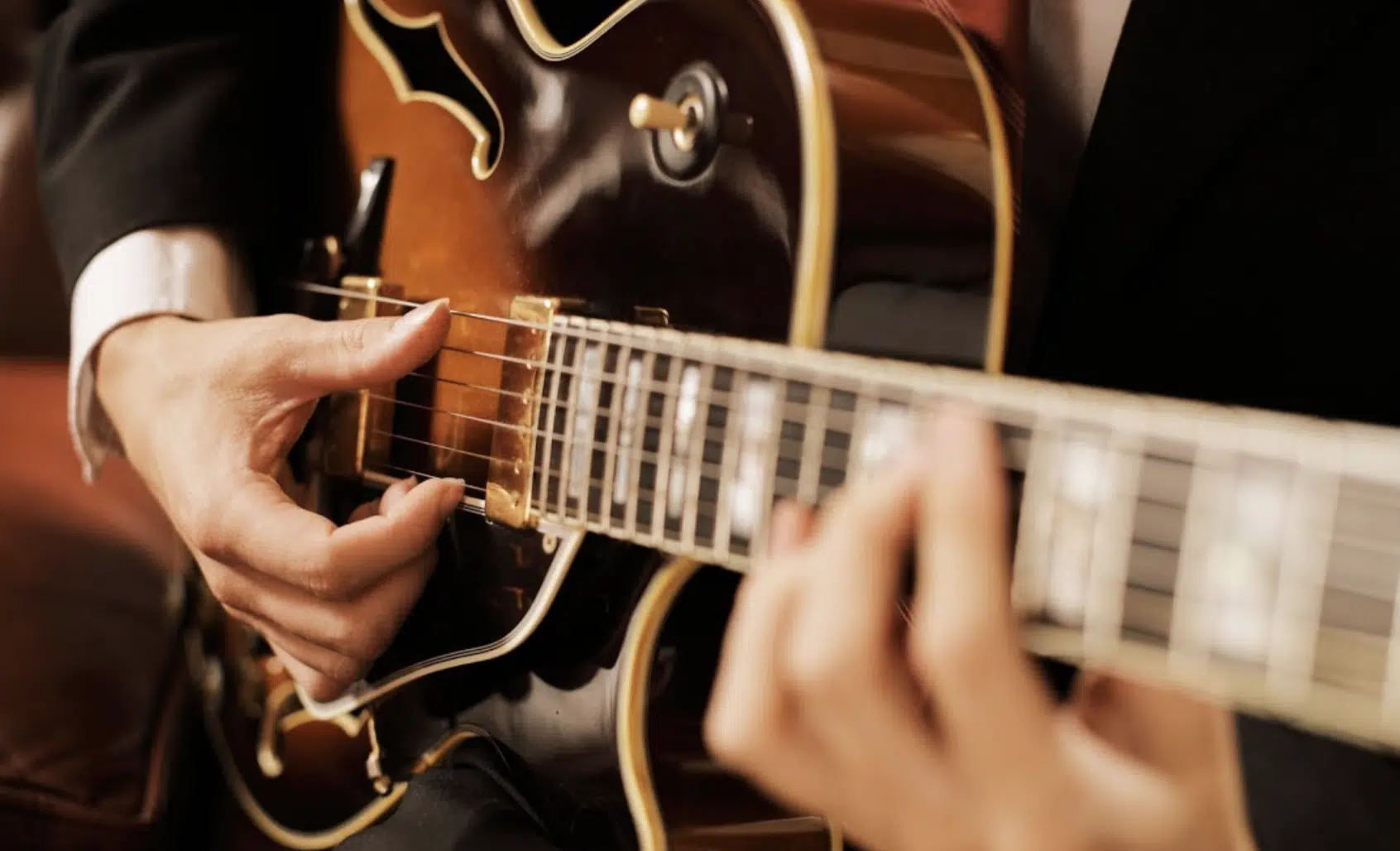
Scale diagrams and suggested fingering are invaluable resources for musicians learning to navigate the major pentatonic scale.
These visual aids depict the layout of the scale on the guitar 一 highlighting optimal finger placements for smooth and efficient movement.
For example, guitarists utilizing the C major pentatonic scale can refer to diagrams that illustrate the scale’s first position.
It will start on the root note C at the third fret of the A string.
Suggested fingering might recommend using the second finger for the root note, then moving across the fretboard in a pattern that:
- Optimizes hand positioning.
- Minimizes unnecessary movement.
This approach not only enables quicker learning and memorization but also enhances playability 一 allowing for more expressive performance and improvisation.
Additionally, scale diagrams for the G major pentatonic scale might show multiple positions, each offering different sonic possibilities.
For instance, the open position allows for the use of open strings, giving a particular resonance and ease of play that’s ideal for beginners or acoustic tracks/performances.
On the other hand, playing the same G major pentatonic scale up the neck can offer a brighter, more piercing tone, suitable for lead guitar work of all kinds.
It’s all about what you’re trying to express and convey.
Using the Major Pentatonic Scale Creatively
The creative application of the major pentatonic scale opens up a world of musical possibilities. By integrating different scales and employing the scale in various contexts, producers and musicians can push the boundaries of their sonic landscapes.
-
Integrating the G Major Pentatonic Scales & E Major Pentatonic Scales
Integrating scales like the G major pentatonic and the E major pentatonic into a single piece can create a rich tapestry of sound, providing depth and variation.
Like any major scale shape, these two are experts at providing that desirable tension.
A song in the key of G major, for example, can utilize the G major pentatonic scale (root note G, A, B, D, E) for its verses to establish a solid, upbeat foundation.
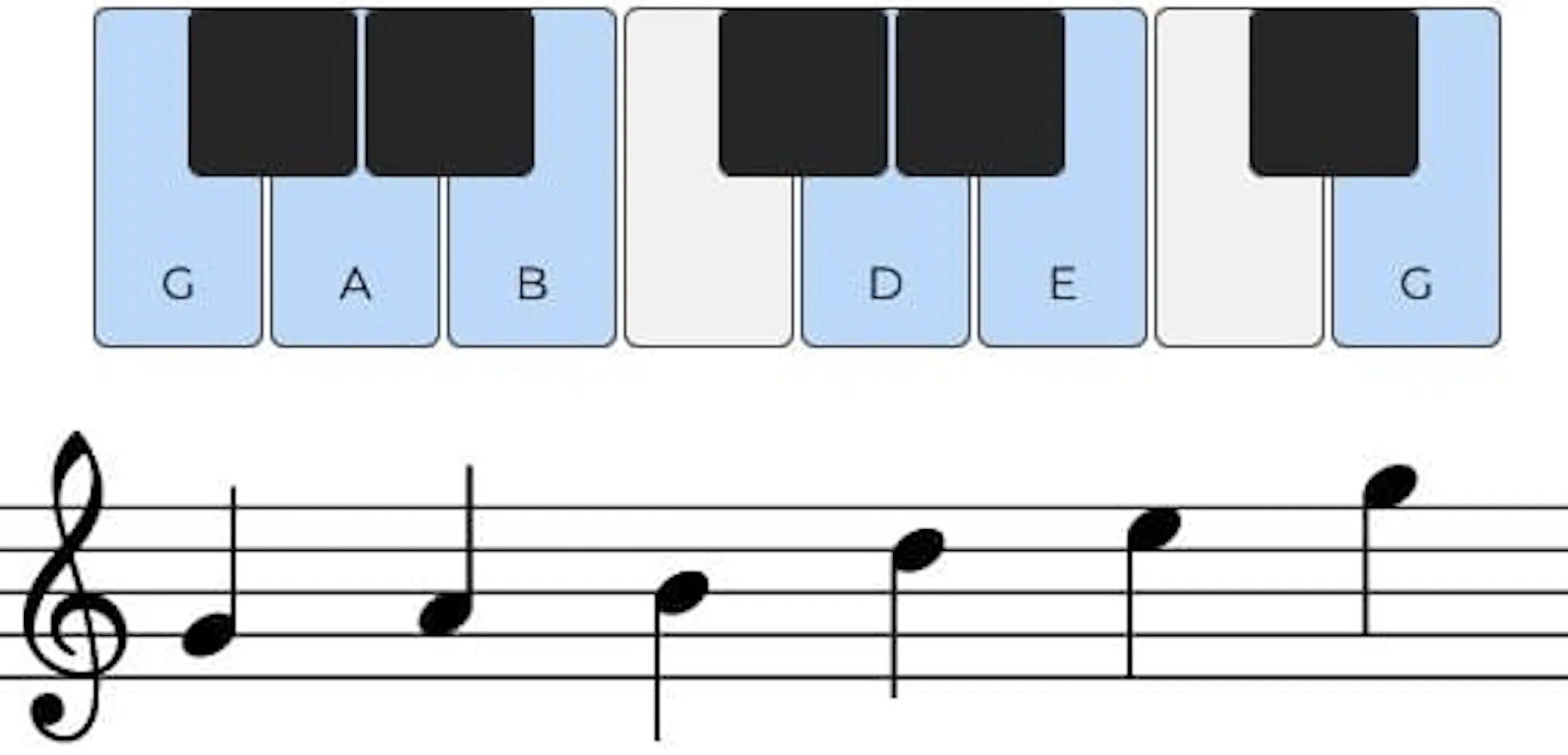
Transitioning to the E major pentatonic scale (E, F#, G#, B, C#) for the chorus or bridge can then offer a contrasting, brighter sound that elevates the overall energy of the track.
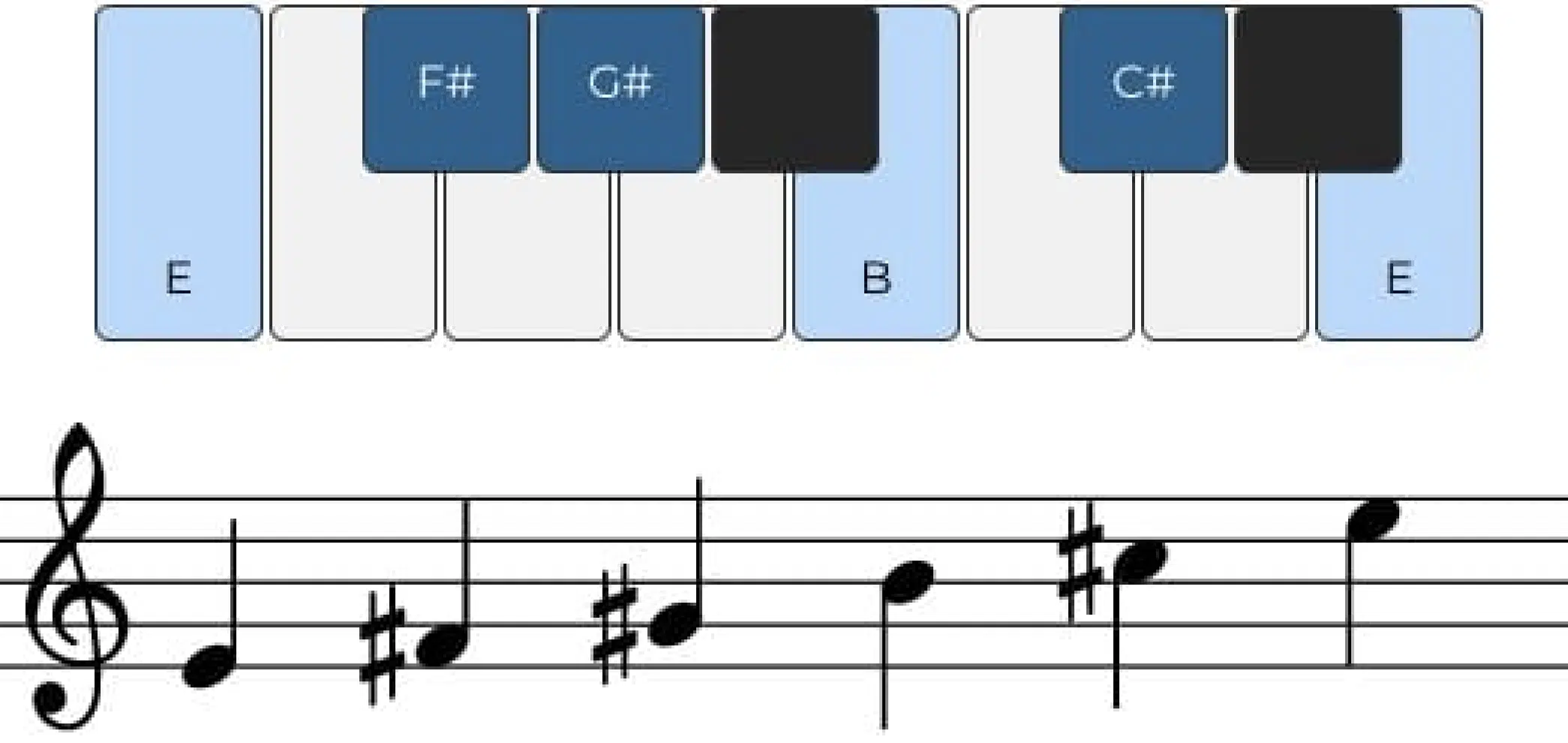
This technique is particularly effective in genres that thrive on dynamic shifts and contrasts (pop, rock, EDM, etc.).
By mastering the use of multiple major pentatonic scales, you can whip up tracks that are complex, engaging, and emotionally resonant.
Remember, don’t count out switching between major/minor pentatonic combos for added intrigue.
-
Exploring Relative Minor Pentatonic Scale Techniques
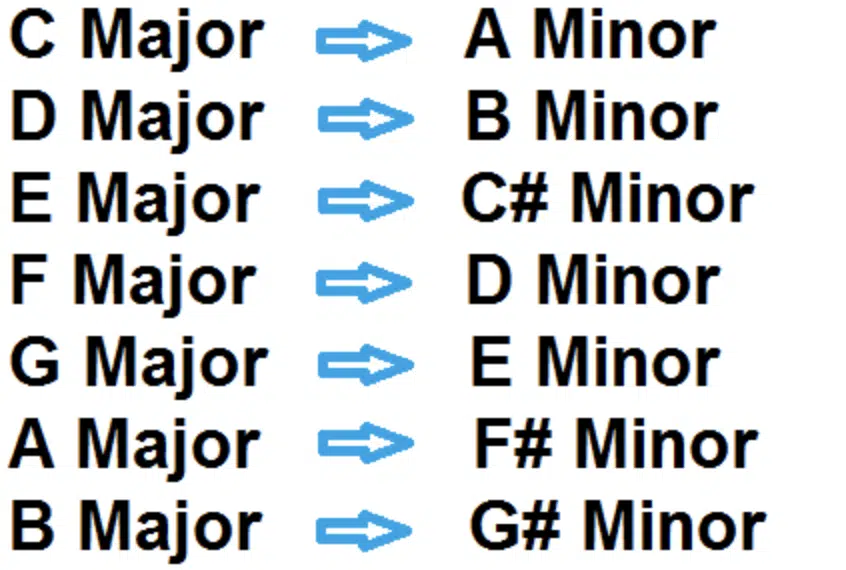
The exploration of the relative minor pentatonic scale shapes add another layer of sophistication to music production.
Every major pentatonic scale has a relative minor pentatonic scale that shares the same notes but centers around a different root note.
For instance, the A minor pentatonic scale (A, C, D, E, G) shares its notes with the C major pentatonic scale.
Therefore, it’s a seamless way to shift between major and minor tonalities within the same piece.
By using the relative minor pentatonic scale shapes you can add that much-desired emotional depth and complexity to your tracks.
In a song primarily in C major, introducing elements in A minor can provide a subtle shift in mood.
Therefore, the minor pentatonic scale is perfect for creating tension or adding a layer of melancholy to an otherwise upbeat track.
By experimenting with a combination of major and minor pentatonic scales in your songs can bring some seriously captivating moods.
-
Programming Pentatonic Scales in MIDI
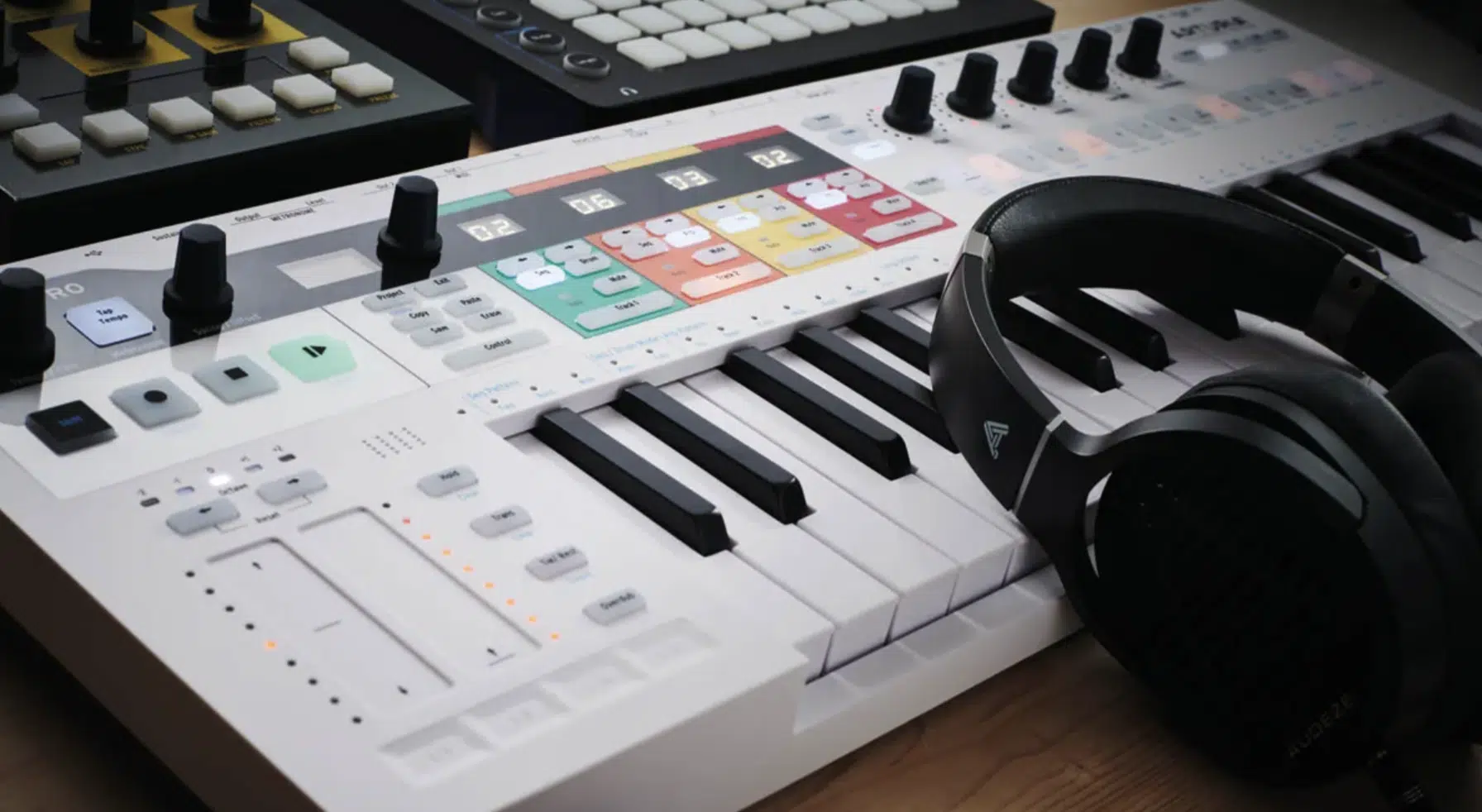
For digital music producers, programming pentatonic scales (whether it’s the minor scale/major scale) with the freedom of MIDI is a game-changer.
It allows for precise control over melodies and harmonies and can easily help you come up with complex breakdowns.
Plus, of course, software instruments can be programmed to play patterns based on the major pentatonic scale, which can help you knock out:
- Solos
- Basslines
- Arpeggiated textures
All of which will adhere to the scale’s flowy nature.
This approach is invaluable in EDM, where the pentatonic scale can be used to generate ethereal pads, lead lines, or bass sequences that fit perfectly, harmonically speaking.
The use of MIDI programming also facilitates experimentation with scale inversions and variations 一 pushing the creative potential of the major pentatonic scale even further.
-
Texturing and Layering with Pentatonic Scales

The major pentatonic scale excels in texturing and layering, providing a cohesive element that unites various parts of a track.
By layering instruments playing different patterns within the same pentatonic scale, you can create a rich, textured sound that adds depth and interest.
The major pentatonic scale provides a harmonious glue that binds elements together like:
- A synth pad playing a sustained chord progression based on the E major pentatonic scale
- A guitar adding melodic flourishes in the C major pentatonic
- A bass line grooving on the root notes
Texturing and layering are especially effective in ambient, chillout, and cinematic music.
This is because the layering of melodic and harmonic elements can create a lush soundscape that transports the listener.
However, it can certainly bring some extra intrigue to any style; just play around with minor pentatonic/major scale variations.
Major Pentatonic Scale: Final Thoughts
The major pentatonic scale, as you now know, is a versatile and melodic tool in music production.
It’s capable of elevating compositions and engaging listeners with its clear, resonant tones.
Also, it can help you simplify the songwriting process and exude that unique charm that captivates audiences across genres.
Using this simple, intriguing scale will help you infuse your tracks with unforgettable melodies and harmonies.
So, go embrace the major pentatonic scale in your tracks and musical journey to create tracks that stay on peoples’ minds long after that last note hits.
Until next time…
Download the Most Legendary Major Pentatonic MIDI Pack Now







Leave a Reply
You must belogged in to post a comment.